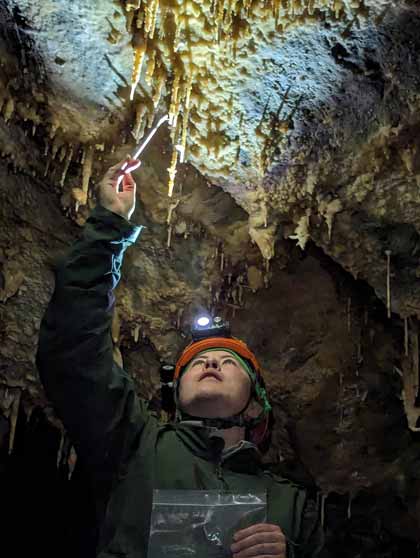
Concealed beneath the many landscapes of North America are a world of hidden waters and hidden life - trapped within the intricate labyrinth of cave and karst systems. These subterranean environments, often overlooked, play a vital role in sustaining life and maintaining ecological balance in regions characterized by water scarcity and changing climatic conditions.

For several years, Great Basin National Park has run a successful citizen-scientist "Lint Camp". Volunteers are recruited to help clean the cave of the annual build-up of lint tracked in by visitors. Photo by Gretchen Baker, NPS.
Our theme for the 2025 National Cave and Karst Management Symposium is "Hidden Waters, Hidden Life". We felt this captures the essence of the thriving ecosystems that exist beneath the surface of the arid west. In a region where surface water is a scarce commodity, these hidden waters become critical reservoirs. The management and conservation of these ecosystems are paramount for ensuring a sustainable and resilient water supply for both the environment and human communities.
Moreover, the theme extends beyond water resources to encompass the diverse and often unique life forms dwelling in these subterranean realms. From threatened bat species to endemic invertebrates with specialized ecological niches, the hidden life in cave and karst systems represents a fascinating tapestry of biodiversity.
"Hidden Waters, Hidden Life" also underscores the cultural and historical significance of these underground environments. Archaeological discoveries in caves provide a window into the past, offering insights into ancient civilizations and the ways they interacted with these subterranean landscapes.
Many caves in this region reveal paleoclimate and paleontological deposits, providing insights into the history of past environments and ancient climates. In the recent past, the most complete fossilized skeleton ever found of a giant short-faced bear (Arctodus simus) was discovered only 30 miles from Ely, Nevada. This creature was the largest North American meat-eater of the Ice Age.
Video compliments of Northern Nevada Grotto
Lastly, all cave and karst regions are interconnected with surface ecosystems through complex hydrological and ecological processes. Effective management requires a holistic approach that considers the entire ecosystem, addressing both surface and underground components. This integrated approach is vital for maintaining the ecological balance of the arid western United States, ensuring the resilience and sustainability of these unique geological formations for future generations.
At the 2025 NCKMS conference in Ely, Nevada, our presentations, workshops, and field trips aim to explore the interconnections of these subterranean ecosystems and deliver a deeper understanding of the intricate web of life that contributes to the ecological richness and resilience of cave and karst systems across North America.
Pseudoscorpions are the top invertebrate predator in Lehman Cave. They are small arachnids, with eight legs. They prey on a variety of insects, including flies, beetles, larvae, and springtails (the bottom of the food pyramid in Lehman Cave). Video courtesy of Great Basin National Park.
The official event schedule for the 2025 NCKMS has now been updated. Please check our schedule page or download a PDF to your mobile device.

Southwest Geophysical Consulting provides geophysical consulting to industry, ranchers, homeowners and government in karst and pseudo-karst areas of New Mexico and surrounding states,

The ghost town of Berlin, Nevada, was established in 1897 as part of the Union Mining District after the opening of the Berlin Mine. At its peak, the town had about 75 buildings and 300 residents. It never prospered to the same extent as other boom towns like Tonopah and Goldfield, and declined following the Panic of 1907. The site was largely abandoned by 1911.
The site was acquired by the state of Nevada as part of Berlin-Ichthyosaur State Park in 1970.